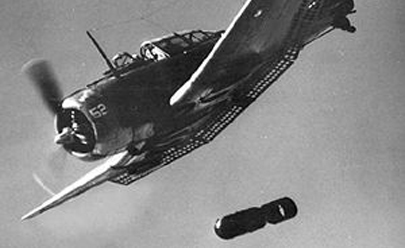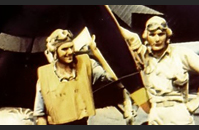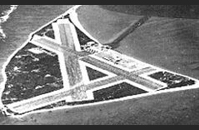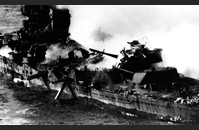THE BATTLE OF MIDWAY AT A GLANCE:

Image Gallery
The Battle of Midway
Location: Midway Atoll 1,300 miles northwest of Oahu
Date: June 4-7, 1942
Background: One of Japan’s main goals during WWII was to remove the United States as a Pacific power in order to gain territory in East Asia. Japan hoped to defeat the US Pacific Fleet and use Midway as a base to attack Pearl Harbor, securing dominance in the region.
Breaking the Code
The United States was aware that the Japanese were planning an attack in the Pacific (somewhere they code-named “AF”) because Navy cryptanalysts had begun breaking Japanese communication codes in early 1942. The attack location and time were confirmed when the base at Midway sent out a false message that they were short of fresh water. Japan then sent a message that “AF” was short of fresh water, confirming that the location for the attack was the base at Midway. Station Hypo (where the cryptanalysts were based in Hawaii) was able to also give the date (June 4th or 5th) and the order of battle of the Imperial Japanese Navy.
The Battle
Early morning on June 4th, aircraft from four Japanese aircraft carriers attacked and severely damaged the US base on Midway. Unbeknownst to the Japanese, the US carrier forces were just to the east of the island and ready for battle. After their initial attacks, the Japanese aircraft headed back to their carriers to rearm and refuel. While the aircraft were returning, the Japanese navy became aware of the presence of US naval forces in the area.
TBD Devastator torpedo bombers and SBD Dauntless dive bombers from USS Enterprise, USS Hornet and USS Yorktown were sent to attack the Japanese fleet. The Japanese carriers Akagi, Kaga, and Soryu, were hit, set ablaze, and abandoned. Hiryu (the only surviving carrier) responded with two waves of attacks—both times bombing the USS Yorktown, leaving her severely damaged, but still afloat (she would later be sunk on June 7th by a Japanese submarine). That afternoon, a USS Yorktown scout plane located the Hiryu and the USS Enterprise sent dive bombers to attack. The attack left the Hiryu burning and without the ability to launch aircraft.
Over the next two days, the US Navy and US forces on Midway continued their attacks, forcing the Japanese to abandon the battle and retreat to Japan. The Japanese lost approximately 4,800 men, four carriers, one cruiser, and hundreds of aircraft, while the United States lost approximately 307 men, one carrier, one destroyer, and over 100 aircraft. This critical US victory stopped the growth of Japan in the Pacific and put the United States in a position to begin shrinking the Japanese empire through a years-long series of island-hopping invasions and several even larger naval battles.
Battle Commanders
U.S. Navy
- Admiral Chester W. Nimitz (Commander in Chief, U.S. Pacific Fleet)
- Rear Admiral Frank J. Fletcher (Officer in Tactical Command, Battle of Midway)
- Rear Admiral Raymond A. Spruance (Commander of Task Force 16, Battle of Midway)
Imperial Japanese Army
- Admiral Isoruku Yamamoto (Commander in Chief, Combined Fleet)
- Admiral Chuici Nagumo (Commander in Chief, 1st Carrier Division)
Download a printable version of this At A Glance
TAKE ACTION:


EDUCATION PROJECTS:
Student Travel – WWII Educational Tours
High school and college students, learn the leadership principles that helped win WWII on a trip to France or during a weeklong residential program in New Orleans. College credit is available, and space is limited.
See You Next Year! HS Yearbooks from WWII
Collected from across the United States, the words and pictures of these yearbooks present a new opportunity to experience the many challenges, setbacks and triumphs of the war through the eyes of America’s youth.
The Victory Gardens of WWII
Visit the Classroom Victory Garden Project website to learn about food production during WWII, find lesson plans and activities for elementary students, get tips for starting your own garden and try out simple Victory Garden recipes!
The Science and Technology of WWII
Visit our new interactive website to learn about wartime technical and scientific advances that forever changed our world. Incorporates STEM principles to use in the classroom.
Kids Corner: Fun and Games!
Make your own propaganda posters, test your memory, solve puzzles and more! Learn about World War II and have fun at the same time.






